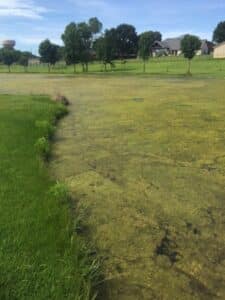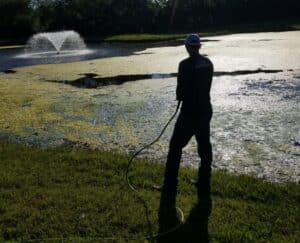
Filamentous Algae Mat
As the days get longer and temperatures start to rise, we will soon be entering algae season here in Texas. Numerous algae species are commonly found in north Texas ponds and lakes. The three major groups of algae are planktonic, filamentous, and branched. Planktonic algae typically cause a cloudy “pea soup” appearance to the water. In severe cases, planktonic algae can cause oxygen depletion and related fish kills. Some species such as blue-green algae can be directly toxic to fish and other wildlife. Branched algae is a harmless group that attaches to the pond bottom. Branched algae is often misidentified as an aquatic plant.
Filamentous algae is by far the most common group. There are several species that appear in various shades of green to light yellow. Due to their thread-like mats that reach the surface, they are often referred to as “pond scum” or “horse-hair algae”. While harmless, filamentous algae can become an eyesore and interfere with recreational use of the pond. Other concerns are the clogging of surface fountains and submersible pumps. In severe cases, filamentous algae can also impact dissolved oxygen levels.
Filamentous algae growth is fueled by nutrients (phosphorus and nitrogen) and sunlight. Shallow, storm-water ponds located in urban areas are the most prone to severe filamentous algae outbreaks. Therefore, communities should always minimize the use of landscape fertilizer around the pond and bag all grass clippings when possible. Large numbers of resident waterfowl also increase the frequency and severity of algae blooms. It is recommended to avoid feeding waterfowl around community ponds.
Homeowners and HOA’s should tolerate some algae during the warmer months (June-September) of the year because it is a natural part of the aquatic ecosystem and the annual cycle of plant growth (Neighborhood Stormwater Pond Maintenance Log and Resources. Sarah Rollins, College of Charleston). However, coverage of more than 20% of the pond can lead to water quality problems.

Treating Algae with Algaecide
Filamentous algae is generally easy to control using EPA approved aquatic algaecides. However, it can re-grow in less than 48 hours after treatment when conditions are optimum (shallow water, high heat, excessive nutrients). Therefore, prevention is often better than control. Methods of algae prevention include pond aeration, approved pond colorants, commercial nutrient binding agents, preservation of native aquatic plants, and mindful landscaping practices.

